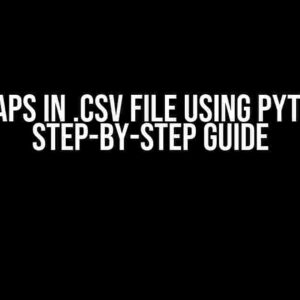Are you tired of waiting for your Snowflake notebooks to finish running? Do you want to take your data analysis to the next level by running multiple tasks simultaneously? Look no further! In this comprehensive guide, we’ll show you how to run Snowflake notebooks in parallel, giving you the power to analyze larger datasets, optimize your workflows, and become a data science rockstar.
- Why Run Notebooks in Parallel?
- Prerequisites
- Step 1: Enable Snowsight
- Step 2: Create a New Snowflake Notebook
- Step 3: Add Cells to Your Notebook
- Step 4: Configure Parallel Execution
- Step 5: Run Your Notebook in Parallel
- Troubleshooting Common Issues
- Best Practices for Running Notebooks in Parallel
- Conclusion
Why Run Notebooks in Parallel?
Running notebooks in parallel is a game-changer for data scientists and analysts. By executing multiple tasks simultaneously, you can:
- Reduce processing time: Analyze larger datasets in a fraction of the time.
- Increase productivity: Focus on high-priority tasks while your notebooks run in the background.
- Improve collaboration: Share results with team members faster, promoting collaboration and decision-making.
Prerequisites
Before we dive into the instructions, make sure you have the following:
- A Snowflake account with a valid username and password.
- A Snowflake notebook with at least one cell containing a valid SQL query or Python code.
- A basic understanding of Snowflake notebooks and Snowsight.
Step 1: Enable Snowsight
Snowsight is Snowflake’s interactive visualization tool that allows you to run notebooks in parallel. To enable Snowsight:
- Log in to your Snowflake account.
- Click on the
Accountmenu and selectAdmin. - Scroll down to the
Featuressection and toggle theSnowsightswitch toON.
Step 2: Create a New Snowflake Notebook
Create a new Snowflake notebook or open an existing one:
- Click on the
Notebookstab in the Snowflake UI. - Click the
+ New Notebookbutton. - Enter a name and optional description for your notebook.
- Choose a template or start from scratch.
Step 3: Add Cells to Your Notebook
Add cells to your notebook containing valid SQL queries or Python code:
| Cell Type | Example Code |
|---|---|
| SQL Query | SELECT * FROM my_table; |
| Python Code | import pandas as pd; df = pd.read_csv('my_data.csv'); |
Step 4: Configure Parallel Execution
To run your notebook in parallel, you need to configure the execution settings:
- In your Snowflake notebook, click the
Runmenu and selectRun Configurations. - In the
Run Configurationsdialog, toggle theParallel Executionswitch toON. - Choose the number of parallel workers from the dropdown menu (up to 10).
- Click
Applyto save your changes.
Step 5: Run Your Notebook in Parallel
Now it’s time to run your notebook in parallel:
- In your Snowflake notebook, click the
Runbutton or pressShift + Enter. - Snowflake will execute your notebook in parallel, dividing the workload across multiple workers.
- Monitor the progress of your notebook in the
Execution Logpanel.
Troubleshooting Common Issues
If you encounter issues while running your notebook in parallel, try the following:
- Check the
Execution Logfor error messages. - Verify that your Snowflake account has sufficient credits and resources.
- Ensure that your notebook cells are independent and don’t rely on each other’s output.
Best Practices for Running Notebooks in Parallel
To get the most out of parallel execution, follow these best practices:
- Optimize your SQL queries and Python code for performance.
- Use data profiling to identify bottlenecks in your dataset.
- Split large datasets into smaller chunks and process them in parallel.
- Monitor resource utilization and adjust your parallel workers accordingly.
Conclusion
By following this comprehensive guide, you’re now equipped to run Snowflake notebooks in parallel, unlocking new levels of productivity and efficiency in your data analysis workflows. Remember to optimize your code, monitor resource utilization, and troubleshoot common issues to get the most out of parallel execution. Happy coding!
# Example Python code to run in parallel
import pandas as pd
import snowflake.connector
# Create a Snowflake connection
ctx = snowflake.connector.connect(
user='your_username',
password='your_password',
account='your_account'
)
# Create a cursor object
cs = ctx.cursor()
# Define a function to execute in parallel
def process_data(chunk):
cs.execute('SELECT * FROM my_table WHERE id = %s', (chunk,))
result = cs.fetchall()
return result
# Create a list of chunks to process in parallel
chunks = [(1, 10), (11, 20), (21, 30)]
# Run the function in parallel using multiple workers
from concurrent.futures import ThreadPoolExecutor
with ThreadPoolExecutor(max_workers=5) as executor:
futures = [executor.submit(process_data, chunk) for chunk in chunks]
results = [future.result() for future in futures]
# Process the results
for result in results:
print(result)
This example demonstrates how to use Python’s concurrent.futures module to execute a function in parallel, processing multiple chunks of data simultaneously. By applying these concepts to your Snowflake notebooks, you can unlock the full potential of parallel execution and take your data analysis to new heights.
Frequently Asked Question
Unravel the mysteries of running Snowflake notebooks in parallel with these frequently asked questions!
Q1: What is the benefit of running Snowflake notebooks in parallel?
Running Snowflake notebooks in parallel enables you to execute multiple tasks simultaneously, significantly reducing the overall runtime and increasing productivity. This feature is especially useful when working with large datasets or complex queries that require extensive processing power.
Q2: How do I run a Snowflake notebook in parallel?
To run a Snowflake notebook in parallel, you can use the ` snowflake-parallel-run` command in your notebook. This command allows you to specify the number of threads or nodes to use for parallel execution. You can also configure parallel execution settings in your Snowflake account preferences.
Q3: What are the system requirements for running Snowflake notebooks in parallel?
To run Snowflake notebooks in parallel, you’ll need a minimum of 2 CPU cores and 8 GB of RAM. However, the recommended configuration is at least 4 CPU cores and 16 GB of RAM for optimal performance. Ensure your system meets these requirements to take full advantage of parallel processing.
Q4: Can I run multiple Snowflake notebooks in parallel simultaneously?
Yes, you can run multiple Snowflake notebooks in parallel simultaneously. This feature is useful when you need to execute multiple tasks or workflows concurrently. Simply open multiple notebooks and use the `snowflake-parallel-run` command in each notebook to execute them in parallel.
Q5: How do I monitor the performance of my Snowflake notebooks running in parallel?
You can monitor the performance of your Snowflake notebooks running in parallel using the Snowflake web interface or the Snowflake CLI. The web interface provides a visual representation of your notebook’s execution, including runtime, CPU usage, and memory consumption. You can also use the CLI to track the execution status and performance metrics of your notebooks.


